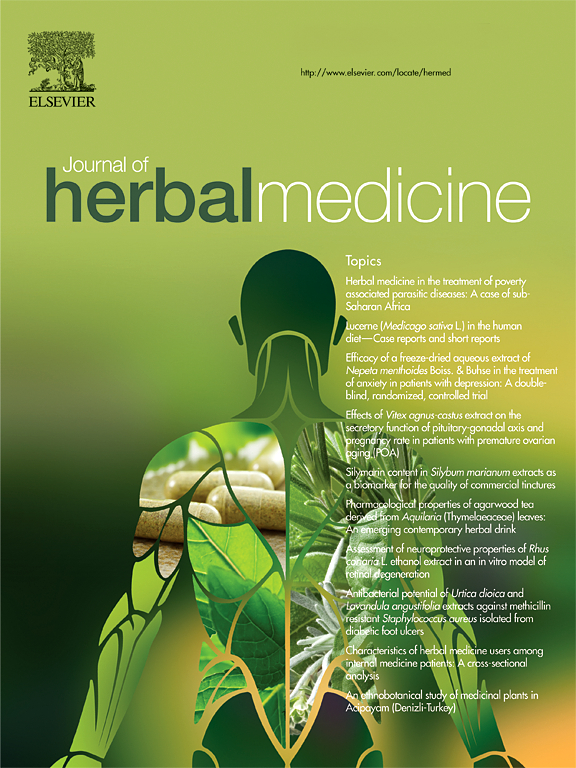婆罗洲沙捞越六个土著社区使用的抗糖尿病植物的民族医学调查
IF 1.9
4区 医学
Q2 INTEGRATIVE & COMPLEMENTARY MEDICINE
引用次数: 0
摘要
沙捞越位于地球上生态最多样化的地区之一,拥有30多个不同的亚民族,每个民族都有自己的文化、语言和生活方式的特点。这促进了许多独特的民族植物学传统的发展。因此,本研究旨在记录六个土著社区的抗糖尿病民族医学知识,并研究他们的文化习俗和信仰如何影响他们各自管理糖尿病的方法。方法在2021年至2024年期间,对来自沙捞越6个土著群体的231名草药从业者进行了实地调查:肯雅(n = 24)、Melanau Igan (n = 71)、Kayan (n = 30)、Iban (n = 81)、Punan (n = 13)和Baketan (n = 12)。民族植物学信息收集采用面对面访谈,通过非结构化和半结构化的方法。该研究记录了6个社区中5个社区34种用于糖尿病治疗的植物物种,总共有127份使用报告。凤仙花(Annona muricata)是最常被引用的物种,在4个群落中有22份利用报告,其次是两个群落的直虹吸(Orthosiphon aristatus),有14份利用报告。在传统知识传播方面存在显著差异,其传输率从肯亚族的25%到梅拉瑙伊根族的91.5%不等。群落间植物知识相似性为0% ~ 35.29%,其中肯雅族和伊班族相似性最高。本研究记录了沙捞越土著居民抗糖尿病植物知识的分布和传播,在物种利用和知识保存方面存在显著差异。知识传输率和从业者专业知识的量化差异表明,在研究群体中,传统知识的保存水平存在差异。本文章由计算机程序翻译,如有差异,请以英文原文为准。

Ethnomedicinal survey of antidiabetic plants used by six indigenous communities in Sarawak, Borneo
Introduction
Sarawak, located in one of the planet's most ecologically diverse regions, hosts over 30 distinct sub-ethnic groups, each with its own set of cultural, linguistic, and lifestyle distinctions. This has fostered the development of numerous, unique ethnobotanical traditions. Thus, this study aimed to document the antidiabetic ethnomedicinal knowledge of six indigenous communities and to examine how their cultural practices and beliefs influenced their respective approaches to managing diabetes.
Methods
Fieldwork was carried out between 2021 and 2024, engaging 231 herbal medicine practitioners from six Sarawak indigenous groups: Kenyah (n = 24), Melanau Igan (n = 71), Kayan (n = 30), Iban (n = 81), Punan (n = 13), and Baketan (n = 12). Ethnobotanical information was gathered using face-to-face interviews through both unstructured and semi-structured methods.
Results
The study documented 34 plant species utilised for diabetes treatment across five of the six communities, with 127 total use-reports. Annona muricata emerged as the most frequently cited species, with 22 use-reports spanning four communities, followed by Orthosiphon aristatus with 14 use-reports from two communities. Substantial differences were noted in traditional knowledge transmission, with rates ranging from 25% in the Kenyah to 91.5% in the Melanau Igan. Plant knowledge similarity between communities ranged from 0% to 35.29%, the highest similarity observed between the Kenyah and Iban.
Discussion/Conclusions
This study documents the distribution and transmission of antidiabetic plant knowledge within Sarawak's indigenous populations, with significant variations in species utilisation and knowledge preservation across communities. The quantified differences in knowledge transmission rates and practitioner expertise indicate varying levels of traditional knowledge preservation among the studied groups.
求助全文
通过发布文献求助,成功后即可免费获取论文全文。
去求助
来源期刊

Journal of Herbal Medicine
INTEGRATIVE & COMPLEMENTARY MEDICINE-
CiteScore
3.90
自引率
0.00%
发文量
94
期刊介绍:
The Journal of Herbal Medicine, the official journal of the National Institute of Medical Herbalists, is a peer reviewed journal which aims to serve its readers as an authoritative resource on the profession and practice of herbal medicine. The content areas of the journal reflect the interests of Medical Herbalists and other health professionals interested in the clinical and professional application of botanical medicines. The objective is to strengthen the research and educational base of herbal medicine with research papers in the form of case studies, original research articles and reviews, monographs, clinical trials and relevant in vitro studies. It also publishes policy statements, opinion pieces, book reviews, conference proceedings and profession related information such as pharmacovigilance reports providing an information source for not only the Herbal Practitioner but any Health professional with an interest in phytotherapy.
 求助内容:
求助内容: 应助结果提醒方式:
应助结果提醒方式:


